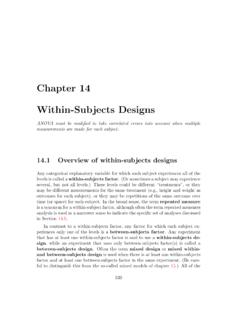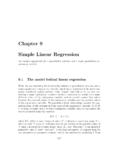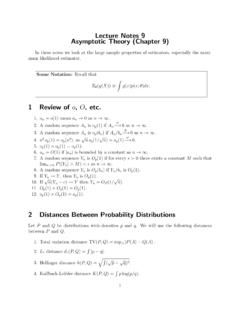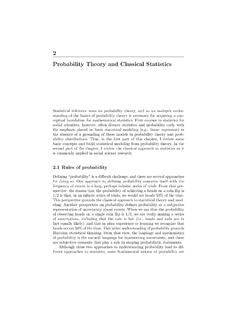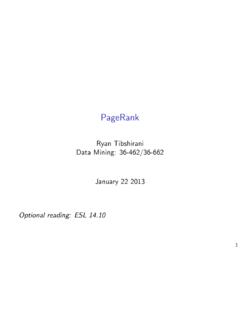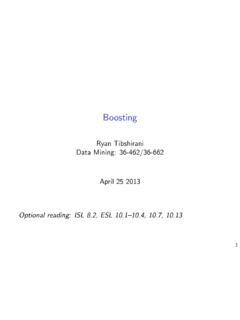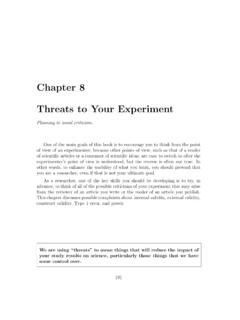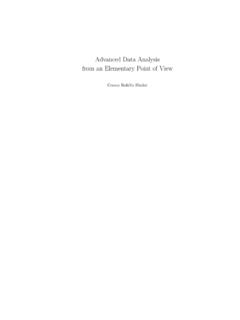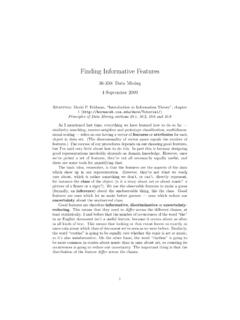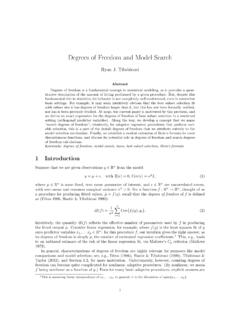Transcription of Distances between Clustering, Hierarchical Clustering
1 Distances between Clustering , Hierarchical Clustering 36-350, Data Mining 14 September 2009. Contents 1 Distances between Partitions 1. 2 Hierarchical Clustering 2. Ward's method .. 3. Picking the Number of Clusters .. 3. Ward's Method in Action .. 4. Single-link Clustering .. 4. Complete-Link Clustering .. 4. 3 How Many Clusters? 4. 4 Reification 8. 1 Distances between Partitions Different Clustering algorithms will give us different results on the same data. The same Clustering algorithm may give us different results on the same data, if, like k-means, it involves some arbitrary initial condition. We would like to say how far apart two clusterings of the same data are.
2 In doing this, we want to accommodate different numbers of clusters, and we want to accommodate the fact that cluster labels are completely arbitrary, so we want to say two clusterings are the same if they only differ by the labels. Recall that a partition of a set divides it into subsets where are mutu- ally exclusive (no point in the set is in more than one subset) and jointly exhaustive (every point is in some subset). The subsets are called the cells of the partition. When we have class labels, the classes partition the data. What we get from a Clustering procedure is another partition. Whenever we have two partitions of the same data, we can build a confusion matrix, just as we did for classifiers; call it A.
3 The entry Aij is the number of items which are in cell i of the first partition and cell j of the second partition. 1. When we did this for classifiers, the first partition was that of the true classes, and the second partition was that of our guesses; we wanted the diagonal entries of A to be big and the rest small, because that meant we were guessing correctly. Two clusterings can be close, however, even if the diagonal isn't, because the numbering of the clusters is essentially arbitrary. One distance measure which does what we want which is invariant under permutations of the cluster labels is what's called the variation of infor- mation Pick a point from the set completely at random, and let X be the cell it falls into according to the first partition, and Y its cell in the second partition.
4 Then the distance is H[X|Y ] + H[Y |X] (1). This will be zero if and only if there is a 1-1 correspondence between the cells of the two partitions. Otherwise, it will be positive, and the larger it is, the less information we get about one partition from the other. (Its maximum possible value is H[X] + H[Y ].). 2 Hierarchical Clustering The k-means algorithm gives us what's sometimes called a simple or flat par- tition, because it just gives us a single set of clusters, with no particular orga- nization or structure within them. But it could easily be the case that some clusters could, themselves, be closely related to other clusters, and more dis- tantly related to others.
5 (If we are Clustering images, we might want not just to have a cluster of flowers, but roses and marigolds within that. Or, if we're Clustering patient medical records, we might want respiratory complaints as a super-cluster of pneumonia , influenza , SARS , miscellaneous sniffling .). So sometimes we want a Hierarchical Clustering , which is depicted by a tree or dendrogram. There are two approaches to Hierarchical Clustering : we can go from the bottom up , grouping small clusters into larger ones, or from the top down , splitting big clusters into small ones. These are called agglomerative and divisive clusterings, respectively. We will return to divisive Clustering later, after we have tools to talk about the over-all pattern of connections among data points.
6 For today, we'll stick to agglomerative Clustering . The basic algorithm is very simple: 1. Start with each point in a cluster of its own 2. Until there is only one cluster (a) Find the closest pair of clusters (b) Merge them 1 It has many names, actually. 2. 3. Return the tree of cluster-mergers Any such procedure is greedy, like our feature-selection algorithm and deter- ministic (no random initial conditions, unlike k-means). It returns a sequence of nested partitions, where each level up merges two cells of the lower To turn this into a definite procedure, though, we need to be able to say how close two clusters are. This is not the same as how close two data points are, or how close two partitions are.
7 There are three basic choices, and a lot of wrinkles. Ward's method Ward's method says that the distance between two clusters, A and B, is how much the sum of squares will increase when we merge them: X X X. (A, B) = ~ A B k2 . k~xi m ~ A k2 . k~xi m ~ B k2 (2). k~xi m i A B i A i B. nA nB. = km ~ B k2. ~A m (3). nA + nB. where m ~ j is the center of cluster j, and nj is the number of points in it. is called the merging cost of combining the clusters A and B. With Hierarchical Clustering , the sum of squares starts out at zero (because every point is in its own cluster) and then grows as we merge clusters. Ward's method keeps this growth as small as possible.
8 This is nice if you believe that the sum of squares should be small. Notice that the number of points shows up in , as well as their geometric separation. Given two pairs of clusters whose centers are equally far apart, Ward's method will prefer to merge the smaller ones. Ward's method is both greedy, and constrained by previous choices as to which clusters to form. This means its sum-of-squares for a given number k of clusters is usually larger than the minimum for that k, and even larger than what k-means will achieve. If this is bothersome for your application, one common trick is use Hierarchical Clustering to pick k (see below), and then run k-means starting from the clusters found by Ward's method to reduce the sum of squares from a good starting point.
9 Picking the Number of Clusters The k-means algorithm gives no guidance about what k should be. Ward's algorithm, on the other hand, can give us a hint through the merging cost . If the cost of merging increases a lot, it's probably going too far, and losing a lot of structure . So a rule of thumb is to keep reducing k until the cost jumps, and then use the k right before the jump. Of course this leaves you to decide how big a merging cost is acceptable, and there's no theory whatsoever to say that 2 We say that one partition is finer than another, or is a refinement of it, if every cell of the finer partition is contained within some cell of the coarser partition.
10 Hierarchical Clustering gives us a sequence of increasingly fine partitions. 3. this will often or even usually lead to good choices, but it does make a kind of sense. Of course, the same rule of thumb can be applied to other Hierarchical clus- tering techniques: pick the k just before the merging cost takes off. Ward's Method in Action Figure 1 shows what Ward's method does with the flower/tiger/ocean images (represented, as usual, by bags of colors). This makes one clear mistake (it thinks flower5 goes with the tigers rather than the other flowers), but otherwise looks reasonable. The merging costs (Figure suggest that there are 3. clusters (or perhaps 6 or 8).)
